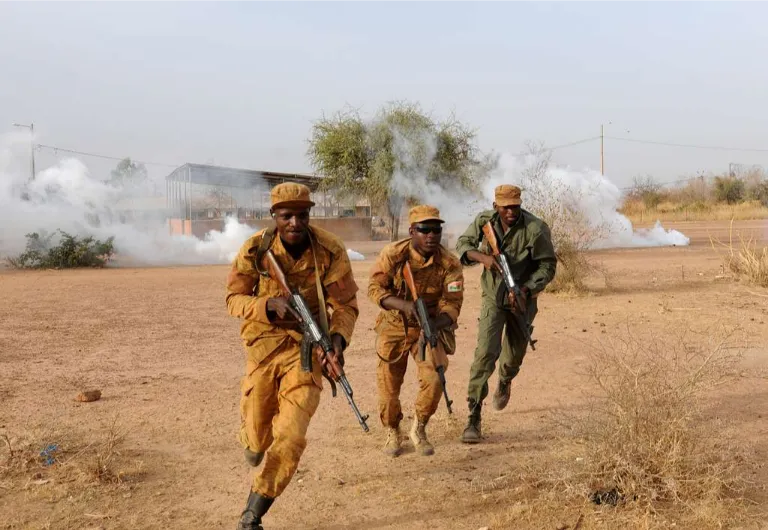Nearly 600 people were killed within a few hours in Burkina Faso by terrorists linked to Al Qaeda. The massacre occurred on August 24, when the terrorists attacked Barsalogho town in Burkina Faso.
This massacre took place just four months after a previous massacre in Soro and Nondin villages in northern Yatenga province where 223 civilians were executed.
The members of Jama’at Nusrat al-Islam wal-Muslimin (JNIM), an Al-Qaeda affiliate based in Mali and active in Burkina Faso, shot down villagers as they swept into the outskirts of Barsalogho on motorbikes.
Eyewitnesses describe the horrific scene as the terrorists shot at close range villagers who were digging trenches to defend their town. Videos of the attack showed some of the villagers lying on the ground and playing dead as the attackers opened fire.
According to a report by France’s top intelligence agencies, the attack, in which most of the victims were women and children, was one of the worst in the West African country’s history, which has been grappling with a terror movement waged by rebels affiliated with Al Qaeda and the Islamic State group that spilled over from neighboring Mali in 2015.
Jihadist fighters affiliated with Al Qaeda and the Islamic State group have killed more than 20,000 people in Burkina Faso and displaced more than 2 million people since 2015 – including some 3,800 this year alone – according to the ACLED analysis group, which tracks global conflict.
The Burkina Faso government has struggled to cope with the threat, and the military has been criticized for its response.
A series of coups in Mali, Burkina Faso, and Niger has led to the departure of French and American forces, creating a power vacuum that has allowed jihadist groups to thrive.
Back-to-back coups in Burkina Faso, in January and September 2022, were precipitated by bloody attacks by armed groups.
The protracted conflict has thoroughly deteriorated the country’s health and food security situation.
As noted by the EU, conflict affects most of the regions in Burkina Faso, especially in bordering areas in the North and East of the country and intensifies in western and southern regions, notably at the border with Niger, Togo and Cote d’Ivoire. Provisional figures for 2024 already document more than 6,100 fatalities, with a large share of civilians.
Estimates for 2024 identify 6.3 million people in need of humanitarian assistance, 27% out of the total Burkinabè population.
More than 2.7 million people will be experiencing crisis levels of acute food insecurity (IPC Phase 3 or higher) and need immediate assistance.
The widespread violence affects people’s basic needs and income opportunities in large parts of the country. Access to fields and markets is challenging, and families cannot always meet their needs. The authorities impose restrictive measures in the context of the ongoing conflict, limiting the movement of populations, impacting their daily life.
The humanitarian response is also severely restrained due to the nation-wide ban on assistance using cash transfers.
These restrictive measures hinder humanitarian access to those in need. Challenges include conflict dynamics, actions by non-state armed groups and the authorities imposed restrictions. Armed convoys, used as a last resort, may cause potentially more harm, dramatically undermining the delivery of assistance to an estimated 1 million people in the 39 locations under blockade.
The conflict severely impacts educational and health facilities.
In May 2024, OCHA reported that over 5,700 schools were closed due to insecurity, depriving more than 800,000 children of education. According to experts on the ground, 426 health facilities are closed due to insecurity, depriving more than 4 million people of access to health care. As a result of this situation, epidemics occur regularly.
The EU has set a good example of what needs to be done to assist Burkina Faso’s civilians.
In 2024, the EU allocated €45 million for humanitarian aid in the country.
These funds support actions on food insecurity and malnutrition, protection, health, nutrition, shelter, water, sanitation and hygiene, education, disaster preparedness activities, and a rapid response to displacements.
EU humanitarian aid focuses on supporting vulnerable internally displaced people and host populations affected by the ongoing armed conflict. In the context of fast-growing crises, particular attention is paid to rapid response to the basic needs of newly displaced individuals and people living in localities under blockade.
Since 2022, the EU has been operating a EU-funded EU Humanitarian Air Flight (EU HAF) helicopter at the service of the entire humanitarian community and EU partners, carrying up to 800 passengers per month, in addition to cargo,
The EU also contributes to building the capacity of local organizations to prepare for, and respond to, emergencies.
Uprooted Burkinabe people and host communities receive food assistance, shelter, and essential items but it is still not sufficient.
Priority must also be given to improved access to health care and mental health support to help people overcome trauma or other protection issues due to conflict.
EU support provides education in an environment where schools have been closed and teachers and students face threats from armed groups.
EU humanitarian aid funds the delivery of emergency food assistance to the most vulnerable in the most affected areas and to the most vulnerable in the areas under blockade during the lean season – the crucial period of the year between harvests, normally running from June to September, when food reserves are depleted.
At the same time, the assistance provides free nutritional care for malnourished children under-5 years old.
The EU also focuses on disaster risk reduction. Ongoing programs include increasing communities’ preparedness to face health risks and strengthening the national response system to prevent and manage future food and nutrition crises.
